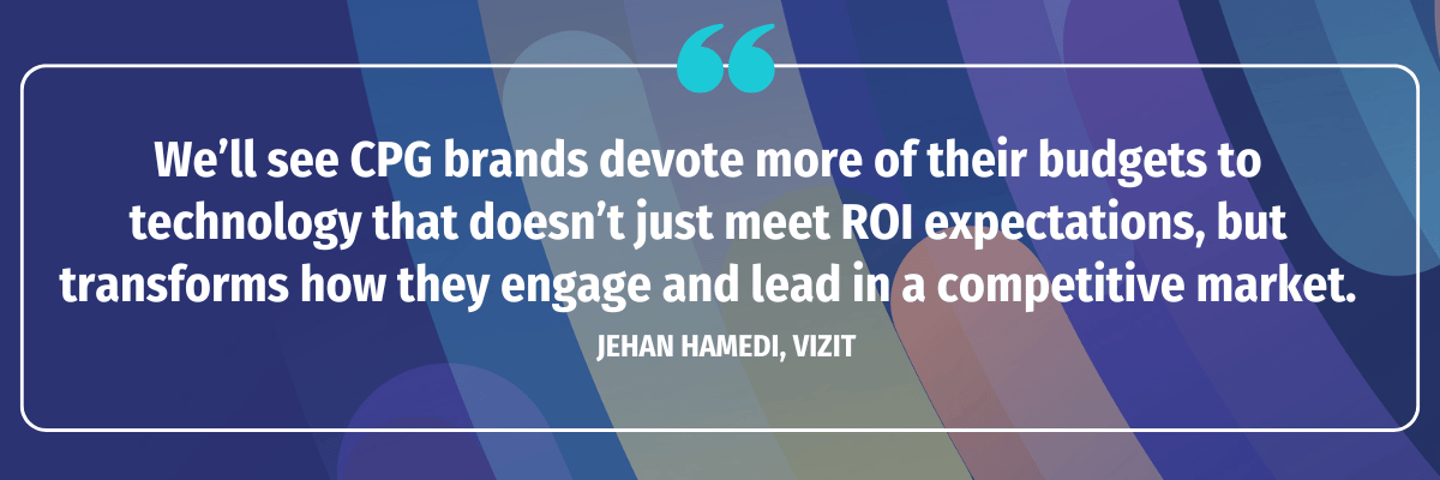2025 Budget Priorities for CPG Tech Leaders
It’s an AI-centric world heading into 2025, and it should come as no surprise that consumer goods companies will invest heavily in the technology.
However, that’s not to say other areas — including digital transformation, customer experience, and composability — aren’t being factored in as key focus areas for CPGs like Mars.
Overall, the focus will continue to be on artificial intelligence and how it can drive front- and back-office improvements, both in cost savings and improved customer engagement, according to Randal Kenworthy, head of consumer and industrial products at consultancy West Monroe Partners, told CGT.
IT investments and budgets are expected to increase next year, and Kenworthy detailed four main priorities CPG leaders have for 2025:
- First, they’ll aim to enhance the tech-enabled customer experience across all channels, emphasizing personalization and seamless service. “This includes leveraging AI to tailor product recommendations and improve customer interactions,” he said.
- Second, leaders are focused on improving supply chain resilience through integrated planning and data-driven insights, addressing challenges like inflation and disruptions.
- A third area of focus will be on advancing smart manufacturing with Industry 4.0 technologies such as automation, robotics, and AI to boost efficiency and flexibility.
- Finally, “leaders are modernizing back-office systems, particularly ERP, to support business agility and streamline operations,’’ said Kenworthy.
Mars' Digital Transformation
For Kyle Barz, senior director of enterprise architecture at Mars, many of these sentiments ring true. He noted that going into next year, there will be a significant investment going toward digital transformation and migrating to a modern SAP S/4HANA environment.
Digital transformation will “unlock speed and agility for the future,’’ Barz said.
Another area of focus will be on the Clean Core Approach, SAP’s philosophy of keeping the core functionality of the platform as close to standard as possible.
Mars will also be prioritizing composability and adding new capabilities into its ecosystem more seamlessly, while IT will move from a project mindset to a product mindset, he said.
“Historically, both at Mars and within the industry, we’ve all been very good at running a lot of projects: A project gets completed … a digital solution is delivered to our customers, and then it quickly starts to age,’’ he explained, so IT doesn’t continue to iterate on software.
Now, leaders are trying to drive “an organizational shift in our thinking and the way we operate,” where there is a continuous iteration on a product so that it keeps driving value for the business.
The idea is to move away from project managers to product owners. The process started a couple of years ago, “but we really have to double down on that to make that culture shift happen at a faster pace,” Barz said.
Mars will also continue its work around data governance, enterprise data models, and data quality, all of which are underpinning AI, he said.
“As we go into 2025, we’re really starting to look at how we can drive the maximum amount of value … and shift out of the proof-of-concept phase.”
Drilling Down on AI
AI has graduated from being a nice-to-have to becoming an imperative for CPGs, noted Merrill. In 2025, CPGs will be zeroing in on AI-based process optimization and personalization, he said.
This will include “AI toward predictive analytics, the smart supply chain, and the promise of hyper-personalized consumer experiences,” Merrill said. “Investments in machine learning algorithms and real-time analytics seek to enhance efficiency and agility toward a shifting set of market requirements.”
Jehan Hamedi, CEO and founder of AI-driven content analytics company Vizit, said that in consumer goods, “the future belongs to those who see AI as more than just a tool — it’s a path to true innovation and differentiation,’’ he said. “IT leaders today are prioritizing AI to drive efficiency and craft experiences that resonate on a personal level” and to connect with consumers in a meaningful way.
But this shift isn’t without challenges, Hamedi added. “Many brands face a skills gap and ethical questions, leading them to adopt a disciplined, test-and-learn approach, particularly with predictive analytics that yield immediate results.”
Listen to how Estee Lauder is Maximizing Generative AI
The CPGs that invest now and see technology as an asset for both efficiency and creativity will set the new standard, he said. “We’ll see CPG brands devote more of their budgets to technology that doesn’t just meet ROI expectations, but transforms how they engage and lead in a competitive market.”
Many CPGs will invest in AI-driven personalization tools to uplift customer engagement, said Chris Dukich, founder of SaaS platform provider Display Now. “From product recommendations to real-time changes in marketing, AI evolves as a priority to boost the personalized consumer experience.”
Automation and the Arrival of Agentic AI
With agentic AI becoming a topic of conversation, Mars’ Barz said investments will be made in agents and automation, using scripts to replace very specific tasks that can be automated and repeated thousands of times.
“As you move forward with more agents that are driving automation, they will start to become more outcome-focused, meaning they learn how to do things.” This will include when there is a disruption in a process or an error in the steps the agent is trying to accomplish, it will learn how to respond to that.
“So it becomes less about the human having to be prescriptive about what to do in every single step and more in the future about how the bots learn to accomplish that on their own,” Barz said.
All aspects of automation to increase operational efficiency will be high on CPG leaders’ agendas, agreed Dukich, adding that there is demand for technologies related to automation in logistics and to reduce operational costs.
“This is an area in which companies are keenly looking toward advanced data analytics and automation in handling supply chain challenges,” he said.
Wish Lists and Supply Chains
In his role at Mars, Barz is responsible for enterprise architecture, and that involves thinking about what the company wants the future to look like from a technology and application ecosystem standpoint. Achieving the goal of a more composable future from a tech standpoint “is a bit of a harder concept to actually execute,” he admitted.
To improve observability, logging, and understanding how flows go across multiple applications means improving engineering abilities.
So the wish list “becomes more about how we build different muscles and a different culture than what we’ve historically had,” Barz said.
CPGs’ wish list technologies often include advanced AI tools and innovative solutions for better data integration and analytics, observed West Monroe’s Kenworthy. Many CPG leaders are also eager to explore augmented and virtual reality as a means of improving online shopping experiences, according to Display Now’s Dukich.
See also: Download to see The Next Big Thing in artificial intelligence
When it comes to the priority of cybersecurity, however, there were some mixed feelings.
Kenworthy noted it “remains a crucial but often underfunded area until a crisis occurs.” However, Cache Merrill, founder of Zibtek, a software development firm that works with CPGs and other enterprises, said enhanced cybersecurity is a top priority and area of investment for the CPGs they work with.
“CPGs are increasingly concerned about customer and supply chain data, and many of them also want to devote fresh resources to advanced security protocols and AI-driven threat detection tools,’’ said Merrill.
Far from a wish list item, the migration to S/4Hana at Mars is heavily tied to enhancing supply chain capabilities, Barz said.
“We’re looking at IoT for the supply chain to better understand how our factories are performing and being able to … potentially predict issues or try to prevent issues that may happen.”







